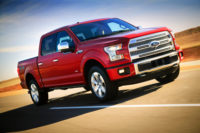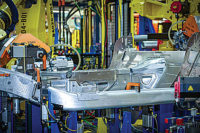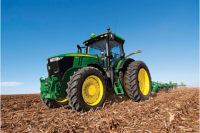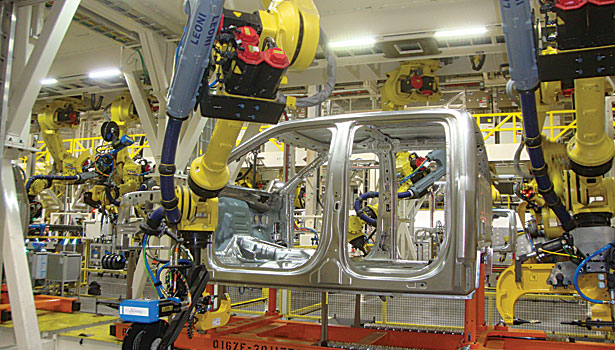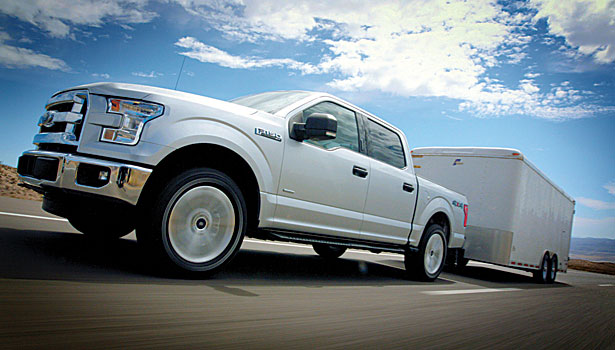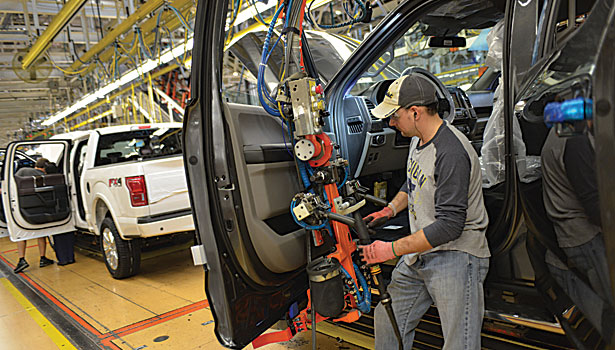Assembling Ford’s Aluminum Wonder Truck

The new F-150 features an aluminum body and cargo box that shave 700 pounds off the top-selling vehicle. Photo courtesy Ford Motor Co.

Traditional spot-welding equipment in the body shop was ripped out and replaced with state-of-the-art technology that allows the F-150 to be assembled with self-piercing rivets. Photo by Austin Weber

The popular F-150 is Ford’s top moneymaker. Photo courtesy Ford Motor Co.

A step-feeding system enables fast cycle rates with flow-drill screws. Photo by Austin Weber

Ford engineers decided to switch from steel to aluminum to improve fuel efficiency and boost performance. Photo courtesy Ford Motor Co.

Unlike conventional riveting, self-piercing technology does not require a predrilled or punched hole. The fasteners pierce and fasten in one operation, simplifying assembly and reducing costs while providing a strong, reliable joint. Photo by Austin Weber

The aluminum-bodied F-150 boasts greater towing and payload capacities than its competitors. Photo courtesy Ford Motor Co.

Hundreds of six-axis robots are mounted on overhead rails at the Dearborn Truck Plant, which frees up floor space in the body shop. Photo by Austin Weber

A robotic visual inspection system automatically validates the dimensions on approximately 80 points on each body. Photo by Austin Weber

The F-150 is available is three different body styles and five basic trim levels. Photo courtesy Ford Motor Co.

Aluminum body panels offer many advantages over steel. One kilogram of aluminum can replace 2 kilograms of steel. The lightweight material also is corrosion-resistant. Photo courtesy Ford Motor Co.

Tape-fed rivets are supplied on reusable plastic spools that each hold several thousand fasteners. Photo by Austin Weber

Roughly the same number of body parts are used in the aluminum version of the F-150 as in the older steel design. Photo by Austin Weber

Ford decided to insource many of the new F-150’s stampings and subassemblies to control production quality. Photo by Austin Weber

The 2015 F-150 boasts all sorts of high-tech features, such as LED headlamps and a 360-degree vision system. Illustration courtesy Ford Motor Co.

The body of the next-generation F-150 is built with approximately 2,000 rivets vs. 5,000 spot welds in the 2014 version. Photo by Austin Weber
















The past and future met recently as the first aluminum-bodied F-150 pickup rolled off the assembly line at Ford Motor Co.’s Dearborn Truck Plant. It was nearly 87 years after another trendsetting vehicle burst onto the scene elsewhere in the massive Rouge Center complex—the Model A sedan.
The next-generation F-150 is one of the most anticipated new vehicles in decades. In fact, some experts argue that it is Ford’s most important product launch since the Model A sedan superseded the Model T in 1927. Ford spent $3 billion developing the new F-150 and the automated production processes used to assemble it.
The revolutionary pickup truck features an aluminum body and cargo box that’s a radical departure from conventional designs. Thanks to liberal use of the lightweight material, the 2015 vehicle is 700 pounds lighter than its predecessor.
The auto industry’s best-selling vehicle now features numerous aluminum body parts, including doors, hood, fenders, floor, roof, side panels, load bed and tailgate.
Roughly the same number of body parts are used in the aluminum version of the F-150 as in the older steel design. However, Ford decided to insource many of the stampings and subassemblies to control production quality.
And, the 2015 vehicle is built with approximately 2,000 rivets vs. 5,000 spot welds in the 2014 version. It marks the first time that mainstream production processes are being deployed to mass-produce an aluminum-intensive vehicle.
The switch to aluminum required Ford engineers to undertake a massive plant retooling effort. Traditional spot-welding equipment was ripped out and replaced with state-of-the-art technology that allows the truck to be assembled with self-piercing rivets, flow-drill screws and structural adhesives, in addition to clinching and laser welding.
When production is fully ramped up by this summer, Ford plans to assemble as many units of its popular pickup in a month as all other aluminum-bodied vehicles combined sell annually.
Historic Plant
The Rouge Center is the heart and soul of Ford Motor Co. The sprawling industrial complex is located along the banks of the Rouge River near Ford’s world headquarters in Dearborn, MI. It was the brainchild of Henry Ford, who integrated many types of just-in-time manufacturing operations at the facility.
When the Rouge opened in 1918, Ford envisioned “a continuous, nonstop process from raw material to finished product with no pause even for warehousing or storage.” In addition to assembly lines, the original 2,000-acre complex included a steel mill, a foundry, a glass plant and a tire factory.
Ford boasted that the Rouge featured “the largest completely mechanized installation of handling equipment ever installed in any industrial enterprise.” Some observers called it “a cathedral for the industrial revolution.”
In its heyday, the Rouge was 2 miles wide and more than 1 mile long. More than 100,000 people worked in 100 different buildings that featured 120 miles of conveyors. The site was served by a fleet of company-owned ships and had its own railroad with 100 miles of track and 16 locomotives.
The Rouge was designated a National Historic Landmark in 1978. During the past 97 years, the facility has mass-produced millions of famous vehicles, including Fordson tractors in the 1920s, Model A sedans in the 1930s, Willys jeeps and M4 tanks in the 1940s, and Thunderbird sports cars in the 1950s. Between 1964 and 2003, the complex mass-produced the Mustang.
However, after Ford spun off its steel-making operation in the 1980s, the historic manufacturing complex was in danger of closing. Faced with foreign competition and declining market share, some top executives wanted to shutter the facility.
But, in the late 1990s, Bill Ford, Henry’s great grandson who currently serves as executive chairman of the automaker, confronted skeptics and decided not to turn his back on history. Instead, he launched a $2 billion initiative to revitalize the Rouge into a showcase for sustainable 21st century lean manufacturing.
When it opened in 2004, Ford claimed that the ‘born again” Rouge Center featured the auto industry’s most flexible and environmentally friendly assembly line. The plant boasted the world’s largest living roof and was proclaimed to be “a vision of sustainable manufacturing for the future.”
Ford recently invested $843 million to upgrade the Dearborn Truck Plant for aluminum vehicle production. In addition to the 2.6-million-square-foot assembly plant, which serves as the automaker’s flagship factory, the 600-acre Rouge Center includes a stamping plant, an engine assembly plant, and a tool and die plant.
Popular Pickup
The aluminum-bodied F-150 is a big gamble for Ford, because it’s not just any old truck. The truck has been the No. 1 vehicle in North America for decades. In fact, it ranks as one of the most popular vehicles ever.
More than 33 million copies of the F-Series have been sold since the pickup first appeared in 1950. That’s twice as many as the legendary Model T.
The F-Series has outsold every other car and truck in the United States for more than three decades. Ford sold 753,851 of the vehicles in 2014; by comparison, its next-closest rival, Chevrolet, only sold 529,755 of its Silverado pickups.
The product is Ford’s top moneymaker. According to automotive industry analysts, the F-Series is a cash cow that has generated more than $50 billion in profits for Ford during the last 20 years. Some experts claim that it generates gross profits of 40 percent per unit and accounts for more than 75 percent of Ford’s total profits.
The first truck to carry the F-150 badge appeared in 1975. Today, Ford produces several types of F-Series vehicles, including medium- and heavy-duty versions such as the F-250, F-350 and F-450, which feature more powerful engines. Those vehicles are assembled at the Kentucky Truck Plant in Louisville, KY.
However, the light-duty F-150 accounts for 70 percent of F-Series sales. The rugged, reliable truck is favored by many types of customers, including contractors, farmers, ranchers, surfers, tradesmen and weekend warriors.
The F-150 is available is several different body styles, such as a regular cab with two doors; an extended cab with swing-out rear doors; and a crew cab with four doors. It’s available in five basic trim levels—XL, XLT, King Ranch, Lariat and Platinum. And, Ford offers a high-performance version called the Raptor. Prices range from $25,000 to $70,000, depending on engine size, towing capacity and various amenities.
Today’s F-150 is a whole lot different than when its ancestor rolled off the assembly line 65 years ago. The 2015 model boasts all sorts of high-tech bells and whistles. Features include LED headlamps, LED spotlights on each side view mirror and the tailgate, and a 360-degree vision system that uses four cameras. In fact, Ford claims that the next-generation F-150 incorporates more than 100 new patents for various technology and production methods.
Engineers decided to switch from steel to aluminum back in 2009 to improve performance. The bold move ranks as the most complex launch in Ford’s illustrious 112-year history.
“High-strength, military-grade, aluminum alloys…improve dent and ding resistance and save weight,” says Joe Hinrichs, Ford executive vice president and president of The Americas, who previously served as vice president of global manufacturing. “[Other benefits include] better fuel efficiency, greater towing and payload capacities, and improved power-to-weight ratio for faster acceleration, enhanced handling and braking responsiveness.”
Why Aluminum?
To meet increasingly stringent fuel economy standards, automakers must dramatically reduce vehicle weight. That’s why Ford engineers turned to aluminum when they began designing the 13th generation of the F-150.
The previous version of the truck sported an aluminum hood. Ford engineers also gained valuable insight on the material when the automaker owned Aston Martin and Jaguar 15 years ago.
Those two British brands pioneered the use of aluminum bodies on low-volume vehicles. For instance, the Vanquish sports car and the XJ sedan featured a variety of aluminum castings, extrusions and stampings that were held together with structural adhesives and rivets.
Ford engineers also developed new ways to join aluminum with tools and technology other than traditional resistance spot welding, which is prone to variability. They experimented with various mechanical fastener and structural adhesive joining processes, in addition to ultrasonic welding.
Aluminum body panels offer many advantages over steel. One kilogram of aluminum can replace 2 kilograms of steel. The lightweight material is corrosion-resistant and offers an excellent blend of strength and low mass that can help improve fuel economy while boosting performance.
“Our objective was to find materials that allowed us to design the truck to be as tough—or tougher—than the current model, yet could help it be hundreds of pounds lighter for better capability and fuel economy,” says Pete Friedman, manager of Ford’s manufacturing research department. “Out of all the materials we tested, we carefully selected only certain grades of aluminum that met our high performance standards.”
The engineers eventually settled on 5000-series and 6000-series aluminum. The 5000-series can be easily stamped, making it ideal for complex body panels. Friedman and his colleagues selected 6000-series aluminum alloys for outer body panels and cargo bed areas, because they have higher tensile and yield strengths that can resist dents and damage.
All the materials were rigorously tested. In fact, the new F-150 is one of the most tested vehicles in history, having undergone more than 10 million miles of pounding.
“We put the truck through some of our testing longer and further than we have ever done before,” claims Peter Frantzeskakis, Ford development manager. “All of this extra testing proved we were on the right track with our designs and our materials. Particular attention was paid to the new body panels and how they are fastened to the frame.”
While aluminum gets all the attention on the next-generation F-150, steel continues to play an important behind-the-scenes role, especially on the truck’s frame. Ford engineers increased their use of high-strength steel in the frame from 23 percent to 77 percent to improve stiffness and durability, while reducing weight by 60 pounds.
Steel is also used in some body parts. For instance, most of the anti-intrusion door beams are steel tubes; there are several small tapped steel plates in the bed sides; and the bottom edge of the tailgate is steel.
Ford turned to Alcoa Inc. and Novelis Inc. to provide a steady supply of lightweight material for the new F-150. Along the way, Alcoa engineers developed a new way to mass-produce aluminum sheet.
The Micromill process changes the microstructure of the metal, allowing the production of an aluminum alloy that has 40 percent greater formability and 30 percent greater strength than traditional aluminum, while meeting stringent automotive surface quality requirements. And, the new aluminum sheet is easier to shape into intricate forms, such as the inside panels of automobile doors and external fenders.
Another key aspect of the supply agreement is a closed-loop recycling program developed by Novelis. The company recently invested $48 million in a new recycling plant in Oswego, NY, that includes an 81,000-square-foot facility for processing, sorting and storing automotive scrap aluminum.
The Dearborn Truck Plant generates thousands of pounds of scrap every day, because only 60 percent of each six-foot wide roll of aluminum is actually used to make body parts for the F-150. Ford invested $60 million in equipment to separate and shred the scrap before shipping it back to suppliers. In fact, Novelis relies on scrap material for producing 50 percent of its automotive aluminum sheet.
Massive Retooling
Ford engineers spent five years planning the changeover from steel to aluminum. It required one of the biggest retooling efforts since the company switched from building the Model T to the Model A in the mid-1920s.
In late August, the last steel-bodied F-150 rolled off the assembly line at the Dearborn Truck Plant. Workers immediately began ripping up conveyors, robots and other equipment behind it. Construction crews worked around the clock to accomplish the transition in just four weeks.
“Traditionally, this kind of a changeover would require 14 to 16 weeks,” claims Bruce Hettle, vice president of North America manufacturing.
The huge task required the use of more than 1,100 tractor trailers. For speed, the new body shop was built in sections assembled offsite and shipped in pieces; one area of the plant at a time was stripped and then new equipment installed.
“[Equipment we installed at the Rouge Center] includes new press lines to help stamp four different types of high-strength aluminum alloys, and new hydroforming lines that use pressurized oil to form metal tubes into strong support rails for structural soundness,” says Hettle.
“[Other equipment included] a new chemical coating system that prepares the aluminum for high-strength adhesives and a new heat-treat area that bake hardens the alloys, resulting in more robust, durable materials,” Hettle points out. “[In addition], the paint shop was updated with dirt detection technology and increased robotic paint automation.”
The most dramatic changes occurred in the 780,000-square-foot body shop. Hundreds of floor-mounted spot-welding robots and safety cages were ripped out. They were replaced with 500 six-axis robots that are mounted on overhead rails. The new robots are smaller and more compact. As a result, everything in the plant is much more open than before.
“Hanging the robots allows more access to the tooling,” says Ron Ketelhut, chief engineer for body construction. It also makes it easier to maintain equipment and deliver fasteners to the line.
“Without welding guns, the plant is now quieter and cleaner,” adds Ketelhut. “And, we don’t have to worry about all the welding sparks and splatter. I no longer end up with lots of holes in my shirts. In addition, the body shop now consumes only one-third as much energy as in the past.”
However, overall layout of the body shop remained basically the same. “Product flow from beginning to end hasn’t changed much,” says Ketelhut. “We still load and unload parts in the same order.”
When converting the body shop to aluminum production, Ford engineers turned to a variety of suppliers for assistance. Companies involved in the project include Comau Inc. (system integration); FANUC America Corp. (six-axis robots); Henkel Corp. (structural adhesives and pretreatment processes); Henrob Corp. (self-piercing rivets and riveting equipment); Perceptron Inc. (dimensional gauging and inspection systems); Semblex Corp. (flow-drill screws); TOX-Pressotechnik LLC (clinching tools); and Weber Screwdriving Systems Inc. (robotic screwdriving equipment).
Assembly began in mid-September at an initial rate of 30 units per hour. But, the plant recently fully ramped up to 60 units per hour. And, Ford just finished retooling its Kansas City Assembly Plant, which also builds the F-150.
Assembly Innovations
Traditionally, automotive engineers have shied away from aluminum because of joining issues. But, new assembly technology, such as self-piercing rivets and flow-drill screws, is changing that attitude.
Self-piercing rivets have been around for more than 15 years and have successfully been used to assemble a variety of products. However, the new Ford F-150 represents the first wide-scale application of the joining process.
Unlike conventional riveting, self-piercing technology does not require a predrilled or punched hole. The rivet makes its own hole as it is being inserted. The fasteners pierce and fasten in one operation, simplifying assembly and reducing costs while providing a strong, reliable joint.
Self-piercing rivets also emulate the results and quality of spot welding without many of the risks, such as toxic fumes, sparks and noise. And, they boast the same static tensile and peel strength as spot welds, but twice the fatigue life.
Unlike spot welding, self-piercing rivets do not generate heat. They eliminate heat problems associated with spot welding pure aluminum and aluminum alloys, which melt below 800 C.
When there’s easy access to the rear side of a joined surface, self-piercing rivets are used to build the aluminum body and cargo box of the F-150. The Dearborn Truck Plant uses robot-mounted equipment, with the rivet setter and die mounted in a C-frame.
“Self-piercing rivets are a proven technology,” says Ketelhut. “The robots use electric servos, so the joining process is much quieter than spot welding. It’s also easier to sample, check and verify quality.” Process monitoring can be integrated with self-piercing technology to verify that every joint created is of high quality.
“Aluminum joining requires a lot more process control than steel,” Ketelhut points out. “We use a robotic visual inspection system to automatically
validate the dimensions on approximately 80 points of each body.”
Several types of self-piercing rivets are used to build the new F-150, depending on the stack thickness to be fastened. Ford’s assembly line uses tape-fed rivets that are supplied on reusable plastic spools that each hold several thousand fasteners.
Although riveting is the primary joining method used to build the F-150’s aluminum body, several other assembly processes play an important role. For instance, steel flow-drill screws, with a zinc coating for corrosion resistance, are used when there is limited access to the backside of a panel or there is only access to one side. The joining method is used throughout the body in about 15 percent of the joints on the new F-150.
Flow-drill screwdriving has been used by European automakers for more than 15 years in low-volume applications. The process enables one-sided assembly without a C-frame and requires no counter nut.
Flow-drill screws are self-piercing and extruding fasteners that
simultaneously drill through and join two to four sheets of aluminum. As the screw rotates at a high speed, its sharp tip heats and pushes aside metal.
Flow-drill screw installation is a six-step process: heating, penetrating, through draft forming, thread forming, engagement of full threads and final tightening. Once the fastening process is completed, and the joint temperature normalizes, the material contracts around the fastener to create an even stronger structural bond with high shear, pull out and stripping resistance.
A recess area under the head of the screw allows some extruded material to collect there during the forming of the through-draft. As the hole is formed, this material is formed into a thin lip around the top of the threaded hole.
Most of the extruded material goes to the backside of the bottom sheet, where it helps thread engagement and serves as the counter nut. The screw can generate a draft up to three times the thickness of the original surface.
“In addition to one-sided joining, flow-drill screws enable us to use various stack ups of metal, such as changing from thick to thin to thick,” says Ketelhut. “It gives us more design freedom than just using a rivet. We use it throughout the assembly process, including underbody, framing, body side and the cargo box.”
The Dearborn Truck Plant uses an automated screwdriving system. Sensors and control algorithms ensure that each flow-drill screw is inserted with consistent force, torque and depth.
During assembly, screws are blow-fed automatically through a receiving tube and into collet jaws. The jaws hold the screw momentarily until it is pushed down by a descending screwdriving spindle to begin installation.
Ford uses a step-feeding system that allows fast cycle rates. After fasteners are deposited into a hopper, they are lifted out of the pan via an air-actuated step system. Incorrectly positioned screws are ejected by a small air blast back into the hopper area automatically. This prevents any jamming at the tooling or escapement.
At the end of the inline tooling rail, the oriented screws are lined up in the buffer area, which is filled until an optic sensor sees the maximum level and shuts down the track vibration and stepping action. The escapement then singulates and blows one screw at a time, down the feed hose to the remote drive spindle, on demand.
While most attention has focused on new joining processes, such as flow-drill screws, Ford engineers also turned to some old-school assembly techniques, such as clinching, to build the aluminum-bodied F-150.
“[There are] various applications in both standalone presses and robot-carried guns,” says Troy Waldherr, North American sales manager at TOX-Pressotechnik LLC. “The parts we are joining are in the closures, underbody, framing and body side.
“When you add in the parts supplied by Tier One suppliers, there are 150 to 200 TOX joints per truck,” claims Waldherr. “We have the advantage of not needing a part feeder (for a rivet) to form our joint, which reduces weight and cost of both investment and per vehicle parts costs.”
The aluminum-bodied F-150 also uses three times as much adhesive as previous models. More than 350 feet of structural adhesive is used throughout the body to supplement the rivets and screws. The epoxy also blocks noise and moisture.
Laser welding is used to assemble the roof of the new F-150. “It’s edge welded from front to back,” says Ketelhut. “Laser welding allows single-sided joining and it’s fast, clean and reliable.”
Learn more about the F-150 and Ford's Dearborn Truck Plant by viewing these videos:
Looking for a reprint of this article?
From high-res PDFs to custom plaques, order your copy today!




